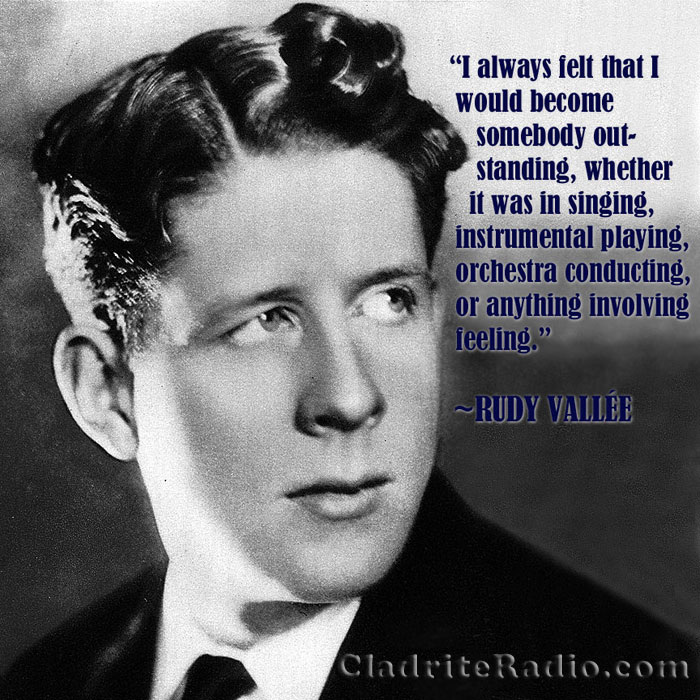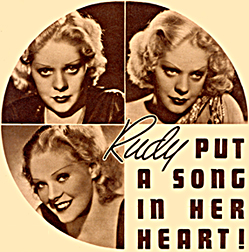Here are 10 things you should know about Betty Grable, born 107 years ago today. Known for her shapely legs, she once said, “I became a star for two reasons, and I’m standing on them.”
Tag: Alice Faye
10 Things You Should Know About Phil Harris
Here are 10 things you should know about Phil Harris, born 119 years ago today. He wore many hats—drummer, band leader, singer, comedian, actor and voice-over artist—and enjoyed success in the recording industry, radio, movies and television.
We’re featuring Harris’ music all day on Cladrite Radio, so tune in now!
10 Things You Should Know About Rudy Vallée
Here are 10 things you should know about Rudy Vallée, born 120 years ago today. One of the earliest teen idols, he went on to enjoy success as a recording artist, in radio, movies and TV, and on Broadway.
We’re featuring Vallée’s music all day today on Cladrite Radio, so why not tune in now?
Happy 115th Birthday, Rudy Vallée!
Rudy Vallée was born Hubert Prior Vallée 115 years ago today in Island Pond, Vermont. He was a huge star as a young man, a true teen idol singing in a brand new style—the Elvis Presley (or perhaps the Justin Bieber) of his day, if you will. Here are 10 RV Did-You-Knows:
- In addition to his vocal talents, Vallée played drums, clarinet and saxophone.
- Vallée’s popular radio program of the 1920s and early ’30s was sponsored by Fleishmann’s Yeast (funny, but you just don’t see or hear that many yeast advertisements anymore).
- Vallée, for all his popularity with the public, was said to be difficult to work with early in his career. He was short-tempered and ever spoiling for a fight, it is said.
- As an orchestra leader, Vallée gave many popular singers their start, among them Alice Faye and Frances Langford.
- Vallée wrote his first memoir in 1930, when he was all of 29.
- His catch-phrase was, “Heigh-ho, everybody!”
- The crooners of the 1920s and ’30s, of whom Vallée was among the most popular, were singing in a new, more intimate, even sexy style that simply wasn’t possible prior to the rise of the microphone. Rudy’s vocalizing may not strike the average listener today as especially sexy, but at the time, it was. If you don’t believe us, just ask him: He insisted on more than one occasion that “People called me the guy with the cock in his voice.” (No, we don’t really understand that, either.)
- He played the romantic lead in several movies at the height of his popularity, but he later switched to more comedic roles, playing stuffy, pompous and sometimes oddball characters. (He’s very funny in Preston Sturges‘ The Palm Beach Story (1942), for example, but one almost wonders if he’s in on the joke.)
- Vallée had a hit in the 1920s with The Maine Stein Song, the fight song for his alma mater, the University of Maine.
- Vallée died in 1986 while watching the Statue of Liberty Centennial ceremonies on television.
Happy birthday, Rudy Vallée, wherever you may be!

Snapshot in prose: Alice Faye
In this series, we’ll explore some career snapshots of familiar Cladrite-era performers, profiles and interviews written long ago that capture the individual at a particular time in his or her career.
The initial entry in the series dates from 1935 and puts the spotlight on the lovely and talented Alice Faye. She’d made only a handful of pictures at this point in time, and was still rumored to be “that way,” as Walter Winchell used to say, about Rudy Vallée. She had yet to wed (or perhaps even meet) Tony Martin, to whom she was married from 1937-1940, or Phil Harris, with whom she would build a long and happy life. They were happily married from 1941 until his death in 1995, and they raised two children together.
But at this point in time, in a profile first published in the June 1935 issue of Popular Songs magazine, Faye’s just hit the big time, with a great career still mostly in front of her.

 hat put the song in Alice Faye‘s heart? What made her change the personality that was hers as a dancer in a night club? Was it her meeting with Rudy Vallee?
hat put the song in Alice Faye‘s heart? What made her change the personality that was hers as a dancer in a night club? Was it her meeting with Rudy Vallee?
I saw Alice Faye recently when she came back from Hollywood on a visit. She had come to the NBC studios to see Rudy and the Connecticut Yankees.
Imagine the delicious curves of her figure emphasized by a chic and tight gown, a little black hat perched over one eye, lithe legs encased in silver silk—and her hair—dozens of little corncolored ringlets curving around those come-hither eyes and pointing to that seductive mouth.
The boys were frankly crazy about her for they crowded about, asking her questions and telling her how glad they were to have her back with them again.
This was Alice Faye of 1935.
Now let us take you back to the Alice of but three years ago.
Do you remember the song?
|
That, my lads and lassies, is an excellent description of the Alice-that-was just a few years ago, an Alice that was coy and sweet, who had medium brown hair that coiled up the back of her neck, who never rouged unless unless she had to and who was afraid of her own shadow.
What transformed the demure little lass with the cast-down eyes into the “hot” blondlined torch singer of the arched eyebrows and the come-hither gaze in her orbs?
It was while the Scandals of 1932 were playing in New York city that Alice Faye met Rudy Vallee. Not really “met” him, mind you, but came face to face with him. For Rudy in 1932 was already sitting on his throne and Alice was just another chorus girl who had yearnings to be something better someday.
Here is Rudy Vallee, a top-notcher on the stage, whispering musical nothings into the shell like ear of Ethel Merman, his co-star. Watching them, her eyes glued on the pair, is a little obscure dancer named Alice Faye whose soul burns and seethes with ambition to rise to stellar heights.
And Rudy probably never knows of her existence, never knows that soon she will be the leading singer in his band, and some say of his heart as well.
It is a long cry now from Alice the chorus girl. Her childhood days spent somewhere in New York city, where she was born, foresaw nothing of the girl who would some day become a dancer in a night club or a red-hot singer of the blues.
Alice worked hard at the Chester Hale Ballet School which she entered right after her graduation from high school. She was the most conscientious pupil they had. She came for her lessons and left when they were over.
From Chester Hale’s, she graduated into a job at the Palais Royal. Theer again it was all work, no play with her. Other girls may have hung around after closing hours, may have flirted and dated with some of the customers, but not Alice Faye. Her thoughts were on a dancing career.
Read More »
